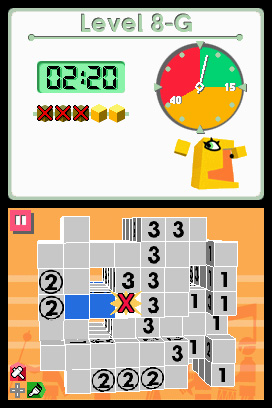Game Review: Picross 3D (DS)
 I was excited to come home after a long trip because I knew that, courtesy of Nintendo, Picross 3D was there waiting for me. I’m a big fan of the previous Nintendo Picross games. One could compare them to Sudoku puzzles. While both puzzles involve numbers, the focus is on logic and deduction rather than any math skills. In basic Picross, a grid is outlined above and to the side with a series of numbers that describe how many squares should be filled in each row or column. A series such as 5 3 2 means that row contains 5 consecutive filled squares, then a break, then three squares, then a break, then two squares. Squares on the grid are slowly filled in using logic and deduction until all appropriate filled squares are found an a picture is revealed. I find Picross much more satisfying than Sudoku because I enjoy the process of creating a tangible picture. The newest entry in the Picross series takes the game into the third dimension. Rather than a simple rectangle, puzzles consist of a three dimensional grid of boxes, some of which have to be removed to reveal the shape hidden inside. At first, I was wary of the changes to the game, but soon found Picross 3D to have much of the original game’s appeal.
I was excited to come home after a long trip because I knew that, courtesy of Nintendo, Picross 3D was there waiting for me. I’m a big fan of the previous Nintendo Picross games. One could compare them to Sudoku puzzles. While both puzzles involve numbers, the focus is on logic and deduction rather than any math skills. In basic Picross, a grid is outlined above and to the side with a series of numbers that describe how many squares should be filled in each row or column. A series such as 5 3 2 means that row contains 5 consecutive filled squares, then a break, then three squares, then a break, then two squares. Squares on the grid are slowly filled in using logic and deduction until all appropriate filled squares are found an a picture is revealed. I find Picross much more satisfying than Sudoku because I enjoy the process of creating a tangible picture. The newest entry in the Picross series takes the game into the third dimension. Rather than a simple rectangle, puzzles consist of a three dimensional grid of boxes, some of which have to be removed to reveal the shape hidden inside. At first, I was wary of the changes to the game, but soon found Picross 3D to have much of the original game’s appeal.
In Picross 3D, puzzles begin with a blank box covered with specific numbers that indicate how many boxes underneath that number need to be kept. Thus, a column of boxes underneath the number zero could be immediately snipped off. Since only one number can be displayed on the face of a stack, numbers surrounded by a circle or a square indicate the boxes you need to keep aren’t consecutive. This leads to the logic part of the puzzles. For example, if the number four (without a circle or square) is showing above a column of five boxes, you can mark the “inside” three boxes to be kept since no matter which four boxes must be kept the only way to have four it a row would be to include the inner three. Similarly, if you have a stack of three boxes showing a number two with a circle, you immediately know you have to keep the outer two boxes and get rid of the inner one. If all that sounds too complicated, don’t worry, the game has a very nice tutorial that leads you through the interface and basic strategy. You are presented with interface and set loose on a few puzzles, then slowly presented with new developments (like the circle or square numbers) and then given more example puzzles to play. Dealing with three dimensions, such as marking or deleting inner-blocks, does take a couple of puzzles to get used to, but the game ramps up in difficulty an a very appropriate manner. In this way, players are led through easy steps to become proficient at solving the puzzles. When all the unnecessary blocks have been trimmed from a puzzle, it becomes colored, becomes animates, and does a little celebration animation. I’m sorry Sudoku, that’s just more satisfying than lining up a bunch of numbers.
As is common with puzzle titles of this sort, you can create your own puzzles to share with friends (WiFi only) even up to including color and some groovy stickers to reward players who complete the puzzle. Other puzzles are occasionally made available for download from Nintendo. Picross 3D is released as a $20 budget title, and for that price it is an excellent value. I freely admit the game is a bit different than a typical puzzle game, so for those still wary of the title, I recommend looking into the free demo download of the game available on the Nintendo Channel over on the Wii console.






July 9th, 2010 at 4:04 am
Picross 3-D is a great value at only 20 bucks. On Easy Mode alone there are more than 120 puzzles! Plus it’s made by HAL Labs, the same folks who created Kirby and Smash Bros., so you know it’s good. –Cary